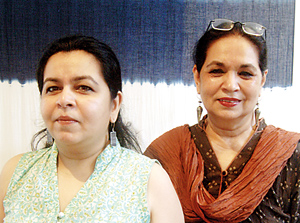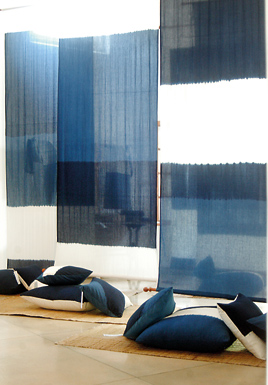An eye for the magical dye
Noorjehan Bilgrami has spent decades fascinated by one colour. Born in Hyderabad, India Noorjehan was still very young when her parents chose to migrate to Pakistan as partition cleaved India in two. Moving to Karachi as a nine-year-old, she would nurture an interest in art until as an adult she made it her calling.

Bringing Indigo to Colombo: Noorjehan and daughter Sarah. Pix by Nilan Maligaspe
However, Noorjehan would bring a historian’s eye to the Pakistani textiles and printing techniques that she encountered in the course of her work. Then with an entrepreneur’s instinct she founded the shop Koel, becoming a leader in a blossoming industry that was making these very crafts fashionable again. Her particular focus became the ancient technique that produced the prints known as ajrak and the colour that had been used by kings of old to colour the designs– indigo.
“What’s amazing is that in literally three months, the leaves of a plant can give you this most incredible blue,” says Noorjehan. “It’s a magical dye, it’s restful to the eye. I find it almost spiritual.” That tug of emotion explains why she has gone to such lengths to resurrect it.
Everyone in the world today recognises indigo – it’s the colour of the jeans you wear – but few own garments coloured by natural dye. When Noorjehan travelled to Japan on a fellowship to conduct research, she found the dye venerated there. Said to be the colour of the sea, it was terribly expensive. Historically, she knew that natural indigo had once been valued in much the same way in the Indian sub-continent, from where it had been exported as early as the Greco-Roman era. Later, the colonial powers promoted forced cultivation of indigo, coercing Bangladeshi farmers to give up rice farming in favour of allowing the plant Indigoferatinctoria to overtake their fields.
Indigo’s popularity began to fail as the European powers moved to counter its success. France banned Indian indigo, claiming it was poisonous and forcing her citizens to rely on a native plant that produced an “inferior” blue, says Noorjehan. As technology progressed, a chemical dye was eventually developed and those with vested interests replaced the traditional dyes with their product. However, the natural colour that stained Egyptian mummy cloths dating back to 2400 B.C and the fabrics unearthed in the ruins of Harappan cities had its own glow, says Noorjehan. Among the more ancient were examples of striped ajrak with alternating white and blue stripes. If Noorjehan marvelled at the ingenuity it took to discover how to make and use indigo, she applauded the artistry and technique required to produce a bolt of ajrak cloth.

“It was in Islamabad that I came across how complicated ajrak is. It actually goes through 21 different stages. It was just mind boggling for me, that I had no clue this was how the fabric was produced,” says Noorjehan. The sharp, geometric prints could be very intricate and the palette was simple though the colours were bold.Out of curiosity she began visiting traditional villages and meeting the dwindling number of craftsmen who could tell her about the art. The research led to her writing a book ‘Sindh joAjrak,’ and later to the making of the documentary‘Sun, Fire, River, Ajrak – Cloth from the soil of Sindh.’ It was also the start of what is today a flourishing business.
Noorjehan is in Colombo at the invitation of the Barefoot Gallery to display a selection of textiles from her company Koel’s workshops. Though they work with many colours (Noorjehan herself is wearing shades of brown), this collection is about celebrating indigo ajrak in garments and household linen. There’s even the odd painting, complete with indigo highlights, on the wall. (An accomplished painter, Noorjehan was one of the founders of the Indus Valley School of Art and Architecture and was its first Executive Director.)
Her daughter Sarah Faruqui has come along to help and is busy arranging items on the rack when we first arrive. It’s been 15 years since Sarah gave up her job in hotel management to join her mother’s business. Growing up, she watched it evolve from a small block printing set up hosted by a close friend in her garage, to a slightly larger workshop and shop that Noorjehan ran out of home and now a three store chain with its own café and gallery spaces. “We now sell our own range of furniture and ceramic pieces in addition to the garments,” she says.
By reinventing ajrak for modern tastes, Noorjehan staged what she calls an “intervention” and it’s been an inordinately successful one. Not content, she proceeded to do pioneering work in encouraging craftsman to go back to their old ways and switch back to natural dyes and handloom cottons and silks. However, to keep her business running, she needed to figure out how to provide consistency.
While researching for her book, Noorjehan would become familiar with the phrase ‘bolrahahai,’ literally, ‘it is talking.’ Leaning over the dye vat, craftsmen would listen for its whisper, waiting to be told when the time was right. “It’s an oral tradition which is passed from generation to generations,” she says comparing it to cooking by instinct. Understanding that it has taken commercial incentives to revitalise the industry, Noorjehan says Pakistan is seeing a revival of some crafts. It helps that ajrak remains popular with locals at the “grass root level.” Tested by years in the business, Noorjehan’s commitment has proved unfaltering. “Once you start working with the crafts people, there’s no turning back,” she says. “It’s not about the shop, it’s about the crafts that just continue.”
‘Romance of Indigo’ by Noorjehan Bilgrami is on from November 3 – 24 at the Barefoot Gallery.



